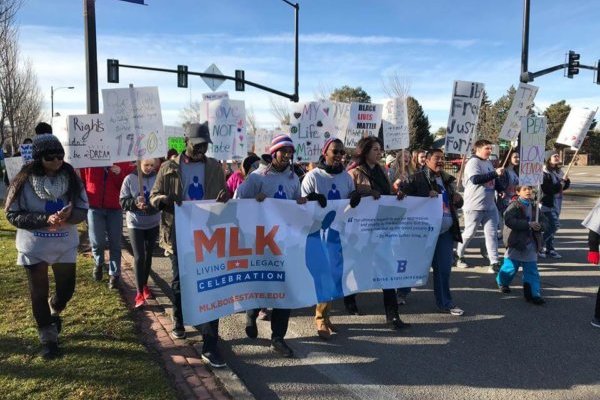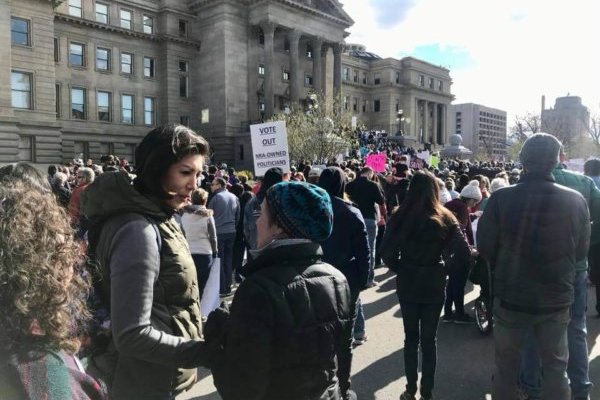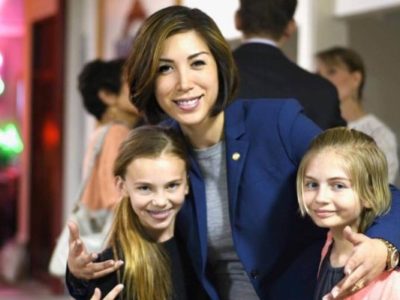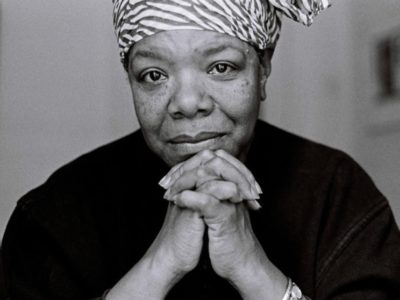With midterm season right around the corner, Paulette Jordan prepares for the final lap in the race towards Idaho’s governor. However, she won’t just hold the position of “governor.” Jordan has the potential to secure the title as Idaho’s first female governor, and the first Native American governor in the United States. With her experience, poise and passion, she represents someone more than ready for the job.
CAREER TIMELINE
2003: Graduated from the University of Washington
2014–2018: Served in the Idaho State House of Representatives
2015–2018: Served on the Business Committee, the Energy, Environment and Technology Committee and State Affairs Committee
Q&A WITH POWERFUL WOMAN LEADER PAULETTE JORDAN
Q: At College Magazine, we work with EMILY’s List, Emerge America, Human Rights Campaign, Higher Heights, She Should Run, Running Start, Victory Fund and IGNITE on an initiative to fight for equal representation in Congress called 50by2050. What are your thoughts on the goal of achieving 50 percent of women in Congress by 2050?
A: I think it’s an ambitious and realistic goal. This year, 23 women currently serve as U.S. Senators and 84 women as U.S. Representatives. In 2017, the United States ranked 104th among 190 countries in terms of women’s representation in government. We have a long way to go to achieve a more equal makeup of men and women in government that is representative not only of gender but of race and socio-economic backgrounds in this country. I am excited that so many women are now stepping up and running for office at all levels of government to bring a necessary balance that has not yet been accomplished in our nation’s history.
Q: What advice do you have for young women running for office?
A: Be unapologetically bold in your decision to run and stay sincere to the issues that matter to you and your constituents. It is important that women running for office remain steadfast in their commitment to their values and bold visions for a more prosperous future for all of us. It’s not enough to fight for the world we know we can get, we must fight for the world we know we deserve.
Q: Have you faced/are you currently facing any specific challenges as a woman running for office?
A: Just 30 percent of Idaho’s current legislature is comprised of women. Idaho has never had a woman governor. I live in a state ranked 50th out of 50 states, according to the Institute for Women’s Policy Research, in women’s employment and earnings, as well as 48th in the nation for women’s reproductive rights. If elected in November, I will be the first woman governor in Idaho ever. I’ll also be the first Native American governor in all of the U.S. This is an incredible opportunity and it comes with much responsibility.
Q: You will potentially hold the title of the United States’ first Native American governor and Idaho’s first female governor. Why do you think that representation is important?
A: As I mentioned, just 30 percent of Idaho’s current state representatives are women. In the state as a whole, the population split is nearly 50-50. While gender and race are not in and of themselves qualifications for holding a government office, combined with experience and leadership, these factors contribute to creating a government that is one of, by and for the people.
As a former leader of the Coeur d’Alene Tribal Council and as a two-term State Representative, I understand the struggles of Idahoans across the state very well. As a mother I see that when we lack quality public education and healthcare, we set our future generations up to continue a cycle of wealth and income inequality that plagues not only Idaho but the entire country.
It is important that we elect leaders who have the interests of citizens as their top priority. It is also imperative to break these barriers for our next generation to see a woman lead in an executive position. My representation in office, once elected, will be empowering and inspiring generations of future leaders who will now have a clearer pathway forward to leadership.
Q: What issues do you hope tackle in Idaho if you are elected governor?
A: Education, Healthcare, Agriculture,Economy, Energy, Criminal Justice Reform and Mental Health/Drug Crisis.

Q: Can you describe your experience as a member of Idaho’s House of Representatives? How has it prepared you for this new political office?
A: The experience has shown me the inner framework to help me maneuver through various channels once elected Governor. I’m thankful to have had the opportunity to serve in the state house as it has allowed me to learn from my peers on both sides of the aisle and to learn more about the many organizations across our great state.
Q: During your first election to the Idaho House of Representatives in 2014 you beat out an incumbent Republican candidate. Are you expecting that same result for this November?
A: That’s the plan, yes. What’s important to remember about this campaign is that I am not running to represent Republicans, Democrats, Independents or Libertarians. I am running to represent all Idahoans. That’s why I believe our campaign message resonates across the state.
I’ve met with people in Northern and Southern Idaho, in rural and more urban areas, and they all tell me that what they want is to have a governor who has their best interests at heart and who has the experience to lead the state in a direction that will reverse our trend of ranking near last in the country in terms of education, healthcare, economic sustainability, etc.
I am an Idahoan first and foremost, and my roots and dedication to the people of Idaho run deep. I refuse to accept corporate or dark money to fund this campaign. It’s time Idaho has a governor who can lead with a compassionate voice of the people.

Q: You were the youngest person elected to the Coeur d’Alene Tribal Council. What was that experience like?
A: It was another great experience and opportunity to learn from my elders. I was able to utilize the position of being a young executive overseeing hundreds of millions, working with national leaders and a Presidential administration to operating a at very local level of governance to build an understanding of the true inner needs of my community. It is an experience that has helped build my foundation of leadership for my state’s future.
Q: How has the gubernatorial campaign differed from your previous campaigns?
A: Campaigning for Governor certainly has its differences that include the amount of finances it takes to fuel the machine of many variables to keep a statewide campaign strong. The current campaign has drawn out people statewide, countrywide and all around the world, so it takes a larger team to handle many components that need to be addressed on a daily basis. We have grown into a campaign that is viewed as a revolutionary movement for rural America.
Q: What has been your experience running as a Democrat with a progressive platform in a traditionally red state?
A: I am running to represent Idahoans. I believe my unique platform can serve to unite citizens of all ideological backgrounds. All Idahoans agree that our children deserve a quality education that prepares them for a prosperous future. When we invest in education we also invest in our communities. Good schools create jobs and increase property values. So does access to healthcare. That’s why I support Medicaid expansion in Idaho.
Idahoans also want a governor who represents everyday citizens, not corporate interests. I am the only candidate in this race who refuses corporate and dark money campaign contributions and the only candidate who does not have a lengthy history of selling Idaho’s public lands to the highest bidder. This grassroots campaign is working with real Idahoans and relying on small-dollar donations and a growing network of volunteers to spread our message to all of Idaho.
Q: What inspired you to run for the office of governor?
A: Having witnessed and experienced the inefficiencies and corruption of government impact my land, neighbors and relatives who face the worst conditions of poverty and many societal ills plaguing what could be a potentially thriving community, I have learned my education and experience belongs to the community who raised me. Because of their many sacrifices, compassion and full faith, I am aware it is my responsibility to protect the people.
My ancestral legacy of leadership stems from thousands of years on these lands, and like my children and my family who have raised me to challenge all odds, they continue to inspire me every day to do more, to challenge the status quo and bring balance back to our state’s government.
HOW TO BE A POWERFUL WOMAN LEADER
1. Be bold
Stringently adhering your beliefs is often easier said than done. Nevertheless, boldness and self-confidence remain the most important components of a strong leader. Jordan said, “Be unapologetically bold in your decision to run and stay sincere to the issues that matter to you and your constituents.” Strong leaders need strong opinions and a strong sense of self.
2. Empower and inspire others
Strong leadership is reflective of strong leaders that came before. To raise strong leaders, we need leaders dedicated to the cause of empowering our youth. “My representation in office, once elected, will be empowering and inspiring generations of future leaders who will now have a clearer pathway forward to leadership,” Jordan said. We can all learn something from Jordan’s centered focus on youth empowerment.
HOW TO CONTACT PAULETTE JORDAN
Like her on Facebook
Follow her on Twitter
Contact her through her website



















